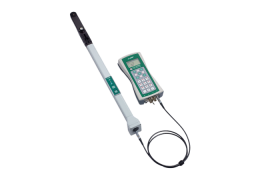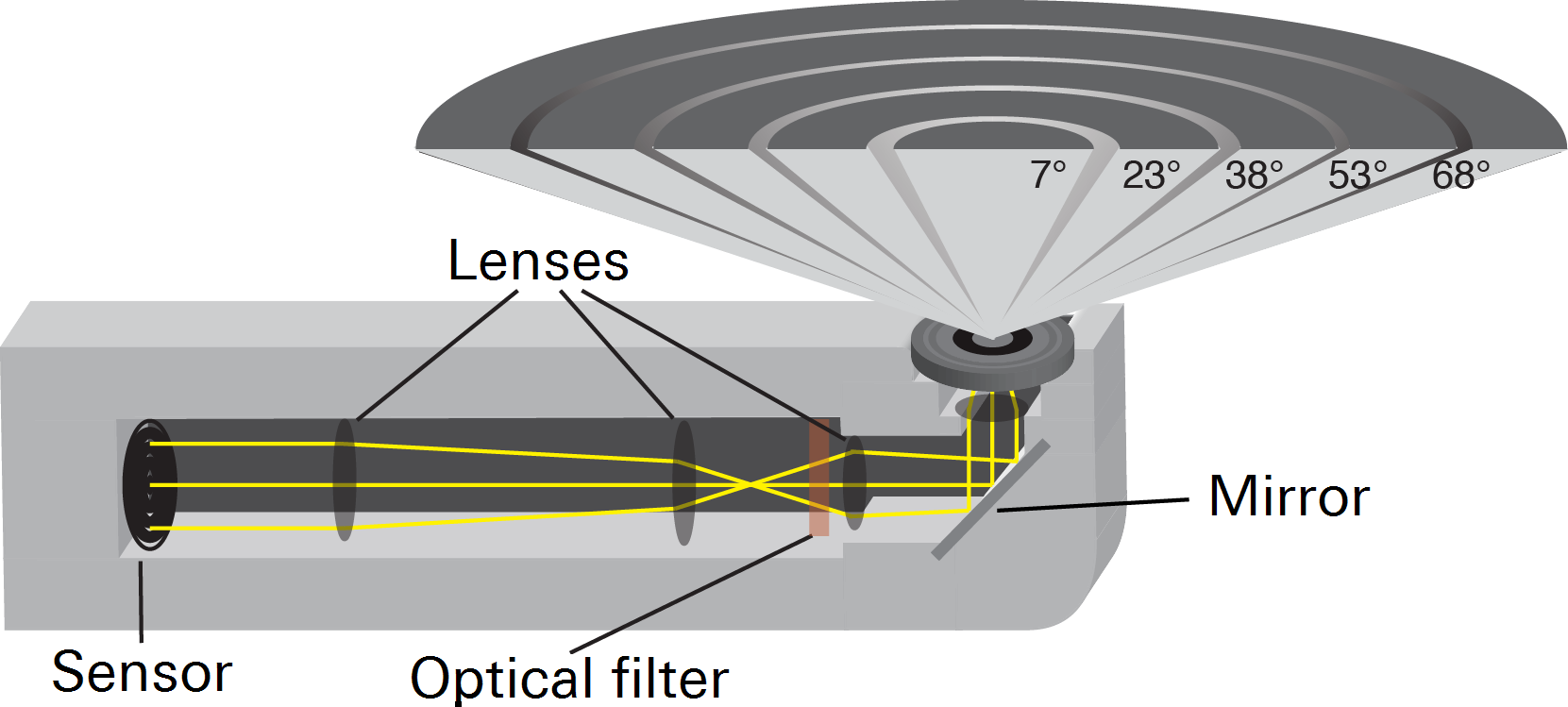Leaf Area Index is one-sided leaf surface area per ground surface area. Because the LAI-2200C is sensitive to all light-blocking objects in its view, the term foliage area index is more appropriate. In scientific literature, the terms effective Plant Area Index (PAIeff) (Garrigues et al. 2008), Vegetation Area Index (VAI) (Fassnacht et al. 1994), and others have been used to refer to indirect LAI measurements that may include non-leafy vegetation. We use the term LAI throughout this manual, except when discussing measurements of isolated plants, in which case we use the term Foliage Density. For more on this, see LAI or Foliage Density? .
Basic Theory
The amount of foliage in a vegetative canopy can be deduced from measurements of how quickly radiation is attenuated as it passes through the canopy. By measuring this attenuation at several angles from the zenith, foliage orientation information can also be obtained. The LAI-2200C measures the attenuation of diffuse sky radiation at five zenith angles simultaneously. The LAI‑2250 Optical Sensor projects the image of its nearly hemispheric view onto five detectors arranged in concentric rings.
If the sensor is level and viewing the sky, detector 1 will measure the brightness straight overhead, while detector 5 will measure the brightness of a ring centered at the 68° zenith angle (22° above the horizon), subtending 13°.
A normal measurement with the LAI-2200C consists of a minimum of ten numbers: five of the numbers are the signals from the five detectors when the optical sensor was above the vegetation, and the remaining five are the readings made with the sensor below the vegetation. For both readings, the sensor is looking up at the sky. Five values of canopy transmittance are calculated from these readings by dividing corresponding pairs. For example, if detector 1 reads 50 (units not important) above the canopy and 5 below, then the transmittance at that angle (centered at 7°) is 5/50 = 0.10. From transmittances at all five zenith angles, the LAI-2200C calculates foliage amount (leaf area index, LAI) and foliage orientation (mean foliage tilt angle, MTA). In practice, a number of below-canopy readings are usually made to improve the spatial average.
Assumptions
There are some basic assumptions that must be met in order to make accurate calculations of foliage density and orientation. The extent to which these assumptions are violated will affect the accuracy of measurements and subsequent calculations. The four major assumptions, in approximate order of importance, are:
- The foliage is black. It is assumed that below-canopy readings do not include any light that is reflected or transmitted by foliage. An optical filter in the LAI‑2250 Optical Sensor rejects any radiation >490 nm. Foliage typically reflects and transmits little radiation in this portion of the spectrum, which helps minimize violations of this assumption.
-
Note: The file viewer software FV2200 version 2.0 and above removes this assumption when you apply the scattering corrections to your data. See Scattering Correction.
- The foliage is randomly distributed within certain foliage-containing envelopes. These envelopes might be parallel tubes (as in row crops), a single ellipsoid (an isolated bush), an infinite box (turf grass), or an infinite box with holes (deciduous forest with gaps).
- The foliage elements are small compared to the area of view of each ring. The approximate guideline is this: the distance between the sensor and the nearest leaf above it should be at least four times the width of the leaf. This relationship is described in more detail later in the manual.
- The foliage has random azimuthal orientations. That is, it does not matter how the foliage is inclined, as long as all the leaves are not facing in the same compass direction. The importance of this assumption is reduced when measurements are made in a wide range of compass directions or without a view-restricting cap.
No real plant canopy conforms exactly to these assumptions. Foliage is never random, but is often clumped along stems and branches, and certainly is not black. Many species exhibit heliotropism, which violates the azimuthal randomness assumption. The practical compromises that must be made are often not serious, however. Many canopies can be considered random, and living foliage does have relatively low transmittance and reflectance of light below 490 nm. Offsetting errors may be common, such as when leaves are grouped along stems (increasing light transmittance), but arranged to minimize overlap (decreasing transmittance).
Some canopies violate these assumptions to an extent that requires consideration. Measurements of conifer canopies, with their high degree of organization, or senescent crops, with thin reflective leaves, might have large absolute errors. The LAI-2200C is very sensitive to small relative differences. In some cases, it might be necessary to calibrate the instrument with direct measurements in order to achieve high absolute accuracy.

